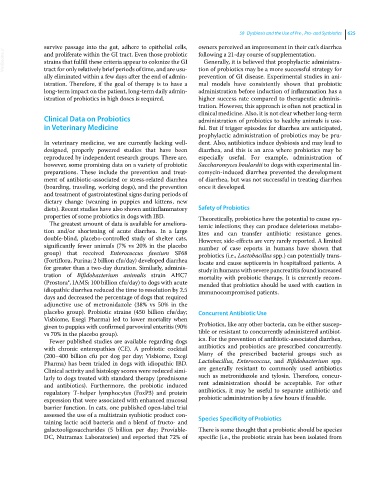Page 657 - Clinical Small Animal Internal Medicine
P. 657
58 Dysbiosis and the Use of Pre‐, Pro‐ and Synbiotics 625
survive passage into the gut, adhere to epithelial cells, owners perceived an improvement in their cat’s diarrhea
VetBooks.ir and proliferate within the GI tract. Even those probiotic following a 21‐day course of supplementation.
Generally, it is believed that prophylactic administra-
strains that fulfill these criteria appear to colonize the GI
tract for only relatively brief periods of time, and are usu-
prevention of GI disease. Experimental studies in ani-
ally eliminated within a few days after the end of admin- tion of probiotics may be a more successful strategy for
istration. Therefore, if the goal of therapy is to have a mal models have consistently shown that probiotic
long‐term impact on the patient, long‐term daily admin- administration before induction of inflammation has a
istration of probiotics in high doses is required. higher success rate compared to therapeutic adminis-
tration. However, this approach is often not practical in
clinical medicine. Also, it is not clear whether long‐term
Clinical Data on Probiotics administration of probiotics to healthy animals is use-
in Veterinary Medicine ful. But if trigger episodes for diarrhea are anticipated,
prophylactic administration of probiotics may be pru-
In veterinary medicine, we are currently lacking well‐ dent. Also, antibiotics induce dysbiosis and may lead to
designed, properly powered studies that have been diarrhea, and this is an area where probiotics may be
reproduced by independent research groups. There are, especially useful. For example, administration of
however, some promising data on a variety of probiotic Saccharomyces boulardii to dogs with experimental lin-
preparations. These include the prevention and treat- comycin‐induced diarrhea prevented the development
ment of antibiotic‐associated or stress‐related diarrhea of diarrhea, but was not successful in treating diarrhea
(boarding, traveling, working dogs), and the prevention once it developed.
and treatment of gastrointestinal signs during periods of
dietary change (weaning in puppies and kittens, new
diets). Recent studies have also shown antiinflammatory Safety of Probiotics
properties of some probiotics in dogs with IBD. Theoretically, probiotics have the potential to cause sys-
The greatest amount of data is available for ameliora- temic infections; they can produce deleterious metabo-
tion and/or shortening of acute diarrhea. In a large lites and can transfer antibiotic resistance genes.
double‐blind, placebo‐controlled study of shelter cats, However, side‐effects are very rarely reported. A limited
significantly fewer animals (7% vs 20% in the placebo number of case reports in humans have shown that
group) that received Enterococcus faecium SF68 probiotics (i.e., Lactobacillus spp.) can potentially trans-
(Fortiflora, Purina; 2 billion cfu/day) developed diarrhea locate and cause septicemia in hospitalized patients. A
for greater than a two‐day duration. Similarly, adminis- study in humans with severe pancreatitis found increased
tration of Bifidobacterium animalis strain AHC7 mortality with probiotic therapy. It is currently recom-
(Prostora®, IAMS; 100 billion cfu/day) to dogs with acute mended that probiotics should be used with caution in
idiopathic diarrhea reduced the time to resolution by 2.5 immunocompromised patients.
days and decreased the percentage of dogs that required
adjunctive use of metronidazole (38% vs 50% in the
placebo group). Probiotic strains (450 billion cfu/day; Concurrent Antibiotic Use
Visbiome, Exegi Pharma) led to lower mortality when
given to puppies with confirmed parvoviral enteritis (90% Probiotics, like any other bacteria, can be either suscep-
vs 70% in the placebo group). tible or resistant to concurrently administered antibiot-
Fewer published studies are available regarding dogs ics. For the prevention of antibiotic‐associated diarrhea,
with chronic enteropathies (CE). A probiotic cocktail antibiotics and probiotics are prescribed concurrently.
(200–400 billion cfu per dog per day; Visbiome, Exegi Many of the prescribed bacterial groups such as
Pharma) has been trialed in dogs with idiopathic IBD. Lactobacillus, Enterococcus, and Bifidobacterium spp.
Clinical activity and histology scores were reduced simi- are generally resistant to commonly used antibiotics
larly to dogs treated with standard therapy (prednisone such as metronidazole and tylosin. Therefore, concur-
and antibiotics). Furthermore, the probiotic induced rent administration should be acceptable. For other
regulatory T‐helper lymphocytes (FoxP3) and protein antibiotics, it may be useful to separate antibiotic and
expression that were associated with enhanced mucosal probiotic administration by a few hours if feasible.
barrier function. In cats, one published open‐label trial
assessed the use of a multistrain synbiotic product con- Species Specificity of Probiotics
taining lactic acid bacteria and a blend of fructo‐ and
galactooligosaccharides (5 billion per day; Proviable‐ There is some thought that a probiotic should be species
DC, Nutramax Laboratories) and reported that 72% of specific (i.e., the probiotic strain has been isolated from

